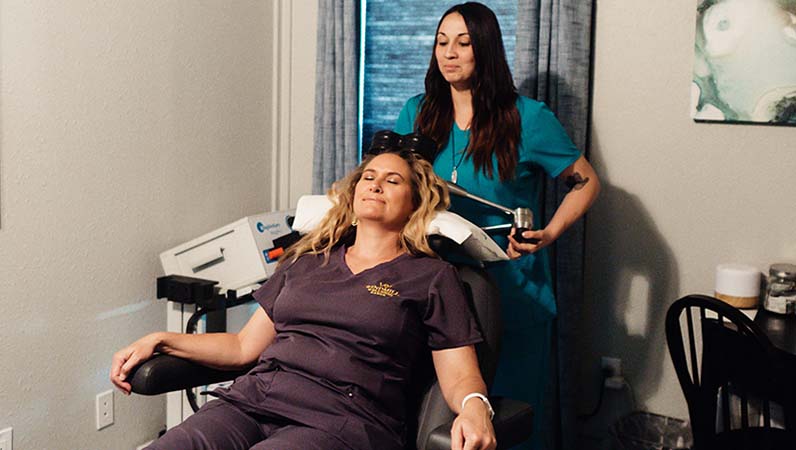Transcranial Magnetic Stimulation for Addiction Treatment
One of the newest tools for treatment of addiction is Transcranial Magnetic Stimulation (TMS). Hard to believe, right? Usually, when people think of addiction treatment, they imagine someone undertaking a rough few weeks of detoxing, in conjunction with group therapy sessions and counseling. Although these activities are an essential part of addiction treatment, the advancement of medical technology has allowed for new and improved forms of treatment. Neuromodulation, delivered through TMS, offers great potential for treatment of substance abuse and addiction.
What is Neuromodulation?
In the broadest sense, neuromodulation is a method of treatment that works by focusing on balancing out activity in the brain. Our brains operate through a series of neurotransmitters and receivers, each stimulating different actions, emotions, and thought processes.
Drug use and certain mental health and medical conditions can hinder or overstimulate normal brain activity. When this happens, a person can experience depression, anxiety, PTSD and other mental health disorders. While many medications can help treat these conditions, they are limited in their effectiveness. Science hasn’t gotten to the point where psychiatric medications work the same for everyone taking them. Neuromodulation, on the other hand, allows a much more individualistic approach.
How Does Neuromodulation (TMS) Work?
Before TMS treatment begins, patients are given an electroencephalogram (EEG), which measures the activity and electrical patterns within the brain. This process entails brain mapping to identify the exact activities of the patient’s brain, setting the stage for customized treatment.
EEGs can reflect the current state of the brain, revealing potential problem areas. The doctor can even see if a concussion occurred and if that had any residual damage. The entire process is non-invasive, takes about five minutes, and causes no pain for the patient.
After the initial EEG, a protocol is set to increase neuromodulation to areas where the brain function has decreased activity. By working to reset the brain frequency to the same rate across all functional areas of the brain, neuromodulation can help regulate brain activities back to normal levels, helping to counter conditions related to brain function and abnormalities. At Windmill Wellness Ranch, an addiction treatment center in Texas, most people report that after TMS treatment, they finally feel “normal” again, or “I haven’t felt this good since I was a child.”
Who Can Benefit from Neuromodulation?
Neuromodulation through TMS has the ability to improve small things, like balance and memory, to much larger scale conditions. Today, although research is ongoing, doctors are using TMS and other forms of neuromodulation to treat
- Depression
- Post-Traumatic Stress Disorder
- Sleep Disorders
- Traumatic brain injuries
- ADHD
and other mental health conditions.
How Can TMS Help Those Struggling with Substance Abuse?
Some of the most difficult struggles in overcoming addiction are due to the impact of drugs and alcohol on the brain. In addition, many patients who deal with addiction also have co-existing mental health conditions such as depression, bipolar disorder, ADHD and anxiety. Initially, they may have used alcohol and drugs to deal with their troubling mental health symptoms. Neuromodulation can be a useful form of treatment for these conditions.
Aside from helping regulate brain activity, neuromodulation can also help alleviate symptoms of pain that some experience during drug and alcohol withdrawal. Anything that relieves the symptoms of withdrawal makes it much easier for patients to make it through the detoxification process, the first step towards recovery.
As a form of treatment, neuromodulation is still in the early stages of development. Further studies will reveal more information about which types of neuromodulation and brain activity are most efficient in treating certain conditions. For addiction treatments, neuromodulation already has practical applications in the treatment process.
How Can I Get Access to This Treatment?
At Windmill Wellness Ranch, we offer the revolutionary PeakLogic PrTMS neuromodulation process as part of our Brain Frequency Center. Through use of EEGs and targeting of areas impacted by substance abuse and addiction – the attention and impulse control areas of the brain – we have seen good results for chronic addiction patients who go through the treatment.
We offer this treatment to any patients who wish to include it in their addiction treatment plan, as well as those who wish to travel to our Brain Frequency Center simply to receive this treatment. Both in-center and outpatient treatments are available.
As studies into neuromodulation progress, we expect to be able to offer more treatments that can help our patients even further on their road to recovery. Until then, we believe that neuromodulation processes can become an essential step for anyone struggling with substance abuse and addiction.
This article is a sponsored post. It is written by Shannon Malish, CEO and Founder of Windmill Wellness Ranch. Shannon has a Master’s degree in social work with an emphasis in addiction counseling and has spent 10 years working in the addiction treatment field. Windmill Wellness Ranch is a co-occurring inpatient and outpatient treatment center specializing in trauma therapies, substance use disorders and mental health. Located in Canyon Lake, TX, near Austin and San Antonio, the center serves patients from across the United States.
APA Reference
Author, G.
(2018, October 30). Transcranial Magnetic Stimulation for Addiction Treatment, HealthyPlace. Retrieved
on 2026, January 1 from https://www.healthyplace.com/blogs/mentalhealthtreatmentcircle/2018/10/transcranial-magnetic-stimulation-for-addiction-treatment
